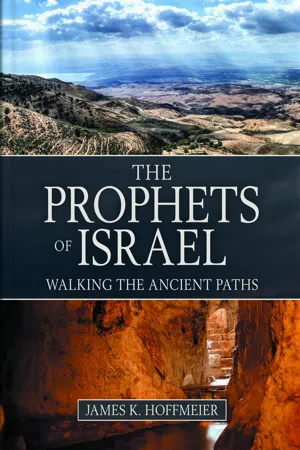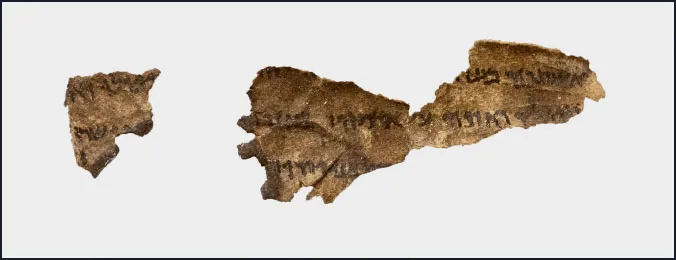![]()
1
INTRODUCTION TO THE HEBREW PROPHETS
THE PROPHETS IN THE BIBLICAL CANON
The prophets of Israel lived and spoke between 2,500 and 3,000 years ago, and yet their voices ring out with some regularity today. Their messages and words survive in the Hebrew Scriptures or Old Testament. We often hear their words but perhaps don’t realize their origin. During the Christmas season, for example, the words of the Israelite prophet Isaiah are ubiquitous in the hymns we sing (e.g., “Lo How a Rose,” “O Come O Come Immanuel”); and Handel’s “Messiah” (also widely played at Eastertime) is replete with the words of Isaiah, the eighth-century B.C. prophet, and other seers. Malachi, the last Israelite prophet of the Old Testament, lived approximately 2,500 years ago, and yet his words “risen with healing in his wings” are sung annually in the classic Christmas carol, “Hark the Herald Angels Sing.”
Likewise the message of these prophets is still quoted today when it comes to justice and social issues. When Dr. Martin Luther King Jr. proclaimed in his “I Have a Dream” speech “but let justice roll down like waters,” he was quoting the eighth-century prophet Amos (5:24) to make his case for civil rights for all citizens of the United States. As a consequence, of such statements, the expression of speaking with a “prophetic” voice is familiar. One who is prophetic denounces injustice and challenges the status quo and the powerful, while advocating for just causes. Similarly, a person who stands alone on an issue may be likened to Isaiah’s “voice of one who cries in the wilderness” (Isa. 40:3). The word “jeremiad,” referring to a long bitter complaint or lamentation (or a piece of literature that does the same), derives directly from the name of Jeremiah, the seventh-century prophet known also as the “weeping prophet.” According to tradition, he was the author of the book of Lamentations. The expression “seeing the handwriting on the wall,” signifying pending doom or bad news, hearkens back to the book of Daniel (5:24–25). Here the vulnerable ruler Belshazzar’s imminent demise was etched on the wall where he was holding a massive party while the Persians were about to invade. It is therefore safe to conclude that the Hebrew prophets continue to leave their mark in Western culture, and naturally for Jews and Christians, the prophetic books are a critical part of their shared Scriptures.
Fig. 1.1 – A Torah Scroll Photo by Alexander Schick/bibelausstellung.de
Browsing the table of contents of most modern translations of the Bible, the reader will notice that the books of Old Testament are divided into rather logical groupings: the Law, the Historical Books, the Poetic books, and the Prophets (see chart). This arrangement is based on the Greek translation of the Old Testament. Commonly known as the Septuagint, the Greek translation was made in Alexandria, Egypt, beginning in the third century B.C. to service the Greek-speaking Jewish community in Egypt (and elsewhere). It seems that the scribes who rendered the Greek organized the canon more by literary categories or genres. Hence the book of Daniel is placed between Ezekiel and Hosea, whereas in the Hebrew sequence, Daniel is found in the third grouping, namely, the Writings.
The Hebrew Bible offers a simpler organizational scheme, consisting of the same books as found in the Septuagint, but just in three units: the Law (Torah), the Prophets (Neviim) and the Writings (Kethuvim). This tripartite structure is reflected in the Jewish tradition of calling the Hebrew Scriptures as Tanakh. The name is an acronym derived by taking the first letter of the three Hebrew words, TNK.
Readers of modern translations may be surprised to see how the Prophets sections vary in the two traditions. In the Hebrew Bible, the Neviim begins with the book of Joshua, followed by Judges, Samuel, and Kings, then Isaiah, Jeremiah, Ezekiel, and then what in the Jewish tradition is known as the book of the Twelve, or simply the Twelve (i.e., Hosea to Malachi). It is not clear why this unit of Scripture includes the so-called “historical” books (Joshua through 2 Kings), although it may be that prophets were the authors or compilers of these.
English/Greek Canon and the Hebrew Canon |
Greek/English Canon | Tanakh/Hebrew Canon |
The Law | The Torah/Law |
Genesis Exodus Leviticus Numbers Deuteronomy | Genesis Exodus Leviticus Numbers Deuteronomy |
Historical Books | Neviim/Prophets |
Joshua Judges Ruth 1–2 Samuel 1–2 Kings 1–2 Chronicles Ezra Nehemiah | (Former Prophets) Joshua Judges Ruth 1–2 Samuel 1–2 Kings (Latter Prophets) Isaiah |
Poetic Books | Jeremiah |
Job Psalms Proverbs Ecclesiastes Song of Solomon | Ezekiel Hosea Joel Amos Obadiah |
Prophetic Books | Jonah |
Isaiah Jeremiah Lamentations Ezekiel Daniel Hosea Joel Amos | Micah Nahum Habakkuk Zephaniah Zechariah Haggai Malachi |
Obadiah | Kethuvim/Writings |
| Jonah Micah Nahum Habakkuk Zephaniah Zechariah Haggai Malachi | Psalms Proverbs Job Song of Solomon Ruth Lamentations Ecclesiastes Esther Daniel Ezra Nehemiah 1–2 Chronicles |
Fig. 1.2 – Dead Sea Scroll Fragment of Amos Lanier Theological Library – photo by Laurel Wilson
According to the first-century-A.D. Jewish historian Josephus, the prophets of Israel were history writers (Contra Apion 1.38–41). This seems to accurately reflect the tradition preserved in 1–2 Chronicles that reports that the author consulted otherwise unknown chronicles written by prophets. The Chronicler actually records the titles of these books and places them as his bibliography at the end of each section on the various rulers. Concerning the reign of David, he lists “The Chronicles of Samuel the seer,” “the Chronicles of Nathan the prophet,” and “the Chronicles of Gad the seer” (1 Chron. 29:29 ESV), and for Solomon, “the history of Nathan the prophet,” “the prophecy of Ahijah the Shilonite,” and “the visions of Iddo the seer” (2 Chron. 9:29 ESV), and “the acts of Uzziah from first to last, Isaiah the prophet the son of Amoz wrote” (2 Chron. 26:22 ESV). Since the books of Samuel, Kings, and Chronicles focus on royal history, that is, the reigns of the kings of Judah and Israel, the prophets who sometimes acted as personal chaplains to the rulers were in an ideal position to record the acts of the kings and comment on the their fidelity to God’s Law.
The Chronicles of Samuel may well be the book of 1 Samuel. Nothing is known of the Chronicles of Gad and Nathan, nor the writings of Ahijah. The book of Isaiah and segments of 2 Kings may well contain portions from what the Chronicler implies was a detailed, chronological report about king Uzziah written by the great prophet. The association of the prophets with the history writing imbedded in the books of Chronicles may account for the inclusion of the books of Joshua, Judges, Samuel, and Kings in the Prophets section. Moreover, the prophet Samuel is a key figure in the first book that bears his name, and prophets such as Elijah and Elisha are known almost exclusively from the books of Kings. These stories about these remarkable prophets may also have influenced the decision to include these more history-based, narrative books in the Neviim.
Fig. 1.3 – Assyrian Scribes writing Nineveh reliefs of Sennacherib. The one on the right is writing on a scroll in Aramaic British Museum – photo by James K. Hoffmeier
The Book of the Twelve
In the Hebrew canonical tradition, what scholars call “the latter prophets” are made up of the three great prophets—Isaiah, Jeremiah, and Ezekiel, but not Daniel—and the so-called twelve minor prophets. These twelve works of varying size were arranged into a single book or scroll by an unknown compiler/s into what is understood to be “a single c...




